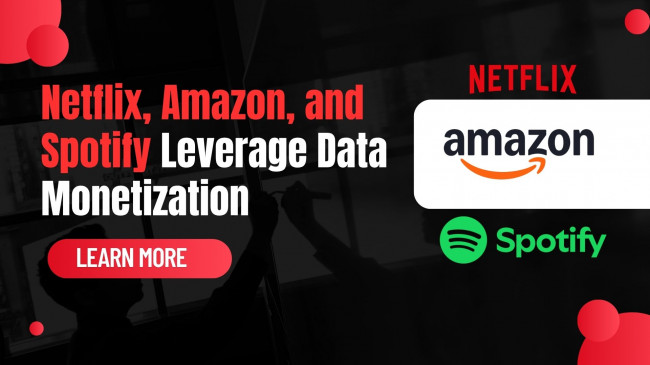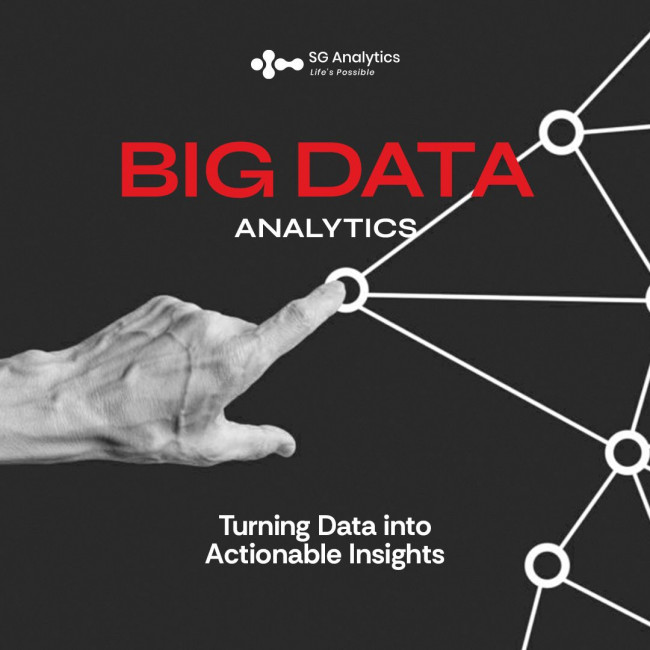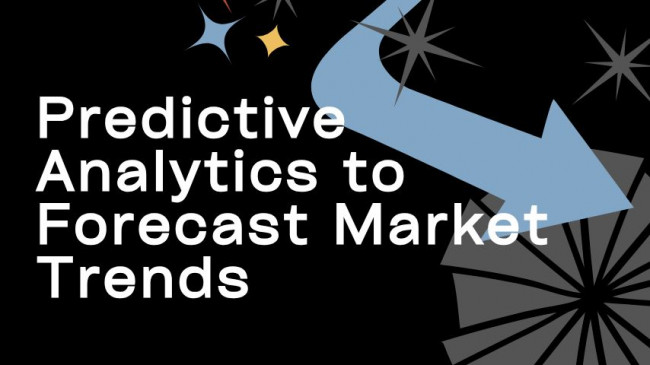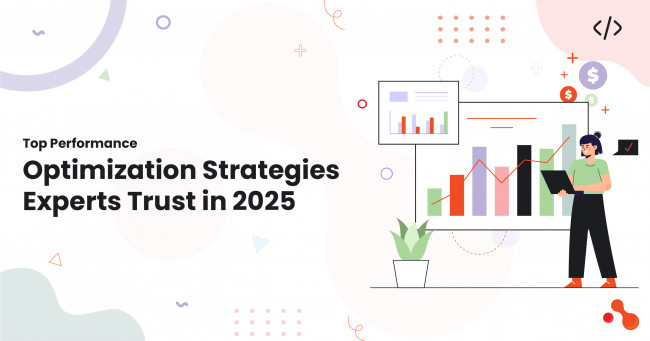In the modern world, the new currency is data, and Netflix, Amazon, and Spotify are at the forefront of discovering its full value. These platforms serve as prime examples of how the data can be monetized to create value, enhance customer satisfaction, and significantly increase revenue. Through data collection, analysis, and strategic implementation, these companies have crafted innovative business models that not only rely on data but also make it central to their operations. In this blog, we will discuss the data monetization strategies of Netflix, Amazon, and Spotify and what businesses can learn from them.
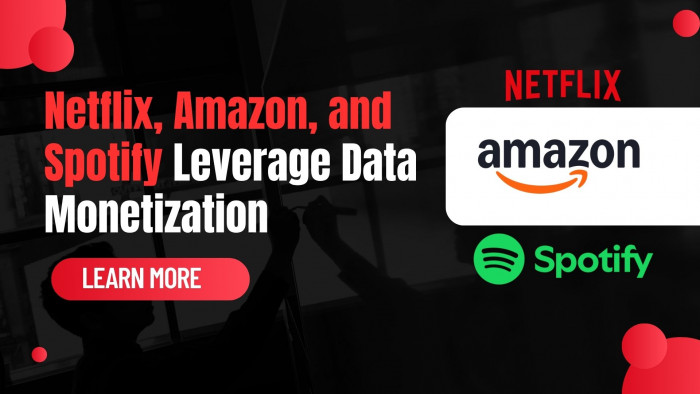
Netflix: Personalization and Subscriber Retention
Netflix shows how companies leverage data to enhance customer satisfaction and drive profits. The streaming giant has over 200 million subscribers globally and uses extensive data to enhance services. One of the most notable data monetization strategies Netflix has is serving content suggestions with high personalization.
Netflix’s algorithms track every click, search, and viewing activity of each user. Tailored recommendations are provided to increase retention and engagement. The more a subscriber watches, the more Netflix learns about their preferences. Ultimately, this results in better recommendation systems designed to keep users coming back for more content, which lowers churn rate and boosts subscriptions.
Apart from personalized recommendations, Netflix also utilizes data to make decisions on what shows and movies to produce. Through data analytics, the platform is able to determine what genres and themes attract user interest the most, enabling investment in content that has a higher chance of appealing to the target audience. This approach has enabled the successful creation of original content such as Stranger Things and The Crown.
Netflix shows how data-based personalization and enhanced content services lead to improved customer retention and content creation. Analyzing customer activities enables businesses to provide more appropriate products or services, which builds long-term loyalty.
Amazon: E-Commerce and Targeted Advertising
Amazon is one of the biggest players in data monetization. Amazon is not only the go-to place for online shopping, but it is also a giant in data. Amazon uses information from different parts of its business, which includes e-commerce, cloud computing, and advertisements.
A big component of Amazon's monetizing strategy is tracking customer purchasing patterns. Each time a user completes a transaction, Amazon captures useful data that predicts future buying decisions. This data allows Amazon not only to customize its product recommendations but also to serve highly personalized advertisements to customers throughout its ecosystem, which includes Amazon.com and other affiliated sites.
Along with customer data, Amazon uses information from a huge network of suppliers to enhance inventory and logistics. Amazon's supply chain management can predict order and consumer demand by analyzing purchase patterns. This ensures popular items are in stock while decreasing the chances of overstocking or understocking.
Amazon is a prime example of how a multi-faceted approach to data can lead to diverse revenue streams. From personalized marketing and predictive analytics to cloud services, businesses can find innovative ways to monetize their data, benefiting both their own operations and those of others. Amazon Web Services (AWS), in particular, offers Data Warehousing Services that allow businesses to store and analyze large volumes of data efficiently. By providing cloud storage and data management tools, AWS helps companies harness the full potential of their data, leading to insights that can improve everything from customer recommendations to inventory management and even cloud-based advertising solutions.
Amazon is an excellent example of how a multi-faceted approach to data creates additional revenue opportunities. Companies now find opportunities to monetize their data through personalized marketing, analytics, and cloud services. Amazon Web Services (AWS) provides Data Warehousing Services that allow companies to store and analyze massive quantities of data.
From personalized marketing and predictive analytics to cloud services, Amazon demonstrates how a multi-faceted approach to data can provide diverse streams of revenue for a business.
Spotify: Data-Driven Music Discovery and Advertising
As the leading music streaming service in the world, Spotify is yet another example of a business that monetizes data efficiently. Spotify has more than 400 million active users and collects a tremendous amount of data from its listeners, including which songs they like, when they listen, and the times they prefer to stream music.
The data monetization strategies used by Spotify include personalized playlists like the ‘Discover Weekly’ and ‘Release Radar.’ These playlists are created for individual users based on their past listening history. Users are able to find new songs that they would love to listen to. This improves Spotify user satisfaction and engagement.
Spotify uses its data for precise ad targeting. As a freemium service, Spotify offers a free tier that comes with advertisements. Spotify serves personalized ads to users based on their specific interests and habits. For instance, for users who often listen to fitness playlists, Spotify may advertise gym memberships or workout clothing. This type of targeting boosts advertising revenue and attracts more advertisers to the platform.
The approach to data monetization can be improved with Data Modernization Solutions that refine the integration and analysis of massive datasets for better targeting and delivery of ads. This ensures a more tailored experience for users as well as advertisers.
Spotify shows how data not only helps improve customer experience but also provides opportunities for targeted advertising. Businesses that understand user preferences will increase engagement and advertising revenue.
Lessons for Businesses
An analysis of Spotify, Netflix, and Amazon reveals how companies can leverage data to improve customer satisfaction and discover new revenue opportunities. Such analysis can help any business. Here are some important observations:
Personalization Drives Engagement: Engaging customers is easier with tailored experiences. Whether it’s content suggestions on Netflix or playlists on Spotify, personalization enhances user interaction. Companies must learn to give customers what they value most and offer more of it.
Predictive Analytics Can Improve Operations: Companies are able to optimize inventories and services based on predicted future demand by analyzing historical customer data. Amazon is a prime example of a company that has optimally streamlined its operations using predictive analytics.
Targeted Advertising is Profitable: One of the most profitable forms of monetization is advertising using data. Advertisers receive better ROI through targeted ads with higher conversion rates driven by customer behavioral analysis.
Data-Driven Content Creation: Data can help not only marketing and operation teams, but also aid in the creation of new products or content. A good example is Netflix's use of data to determine which series to produce.
Monetizing Data Through Services: Another very powerful strategy is offering data as services. AWS by Amazon provides a remarkable example of how businesses are able to monetize their own data while assisting others in managing and analyzing their data.
Conclusion
The Netflix, Amazon, and Spotify stories show how data can be monetized. These businesses have successfully harnessed data’s value to deepen engagement, improve offerings, and create additional revenue. Businesses in all sectors now have to learn how to leverage data if they wish to remain competitive and innovate. Adopting a data-driven approach opens new opportunities, improves customer experience, and drives consistent growth.

